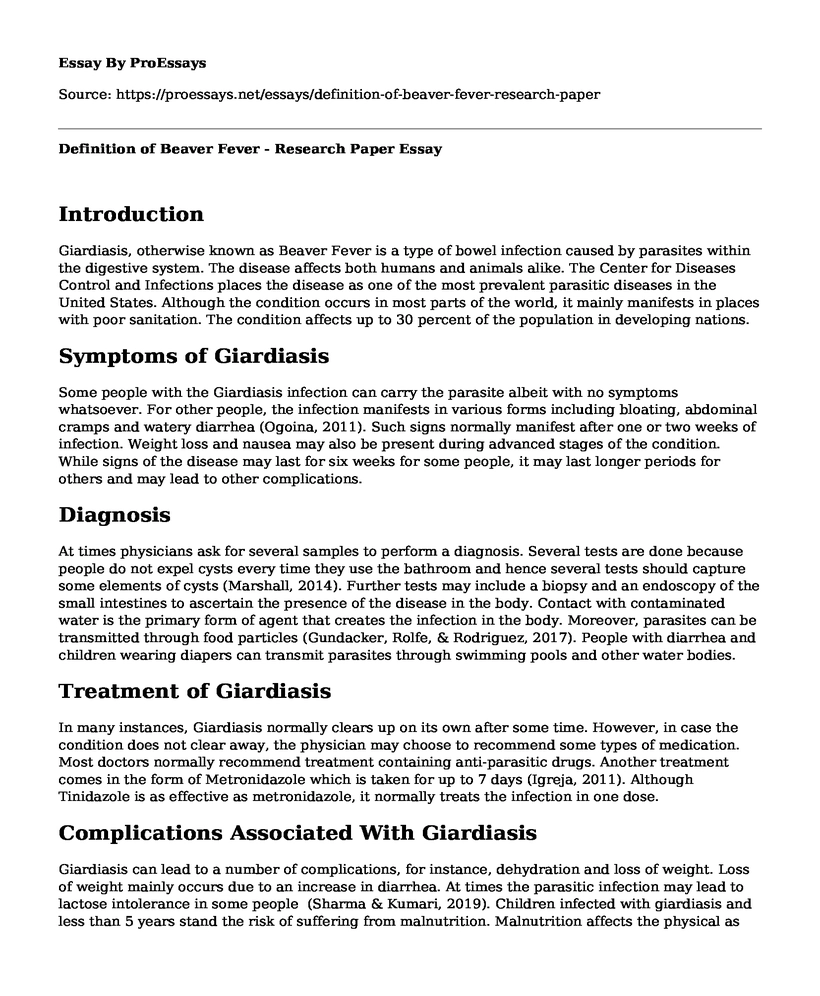Introduction
Giardiasis, otherwise known as Beaver Fever is a type of bowel infection caused by parasites within the digestive system. The disease affects both humans and animals alike. The Center for Diseases Control and Infections places the disease as one of the most prevalent parasitic diseases in the United States. Although the condition occurs in most parts of the world, it mainly manifests in places with poor sanitation. The condition affects up to 30 percent of the population in developing nations.
Symptoms of Giardiasis
Some people with the Giardiasis infection can carry the parasite albeit with no symptoms whatsoever. For other people, the infection manifests in various forms including bloating, abdominal cramps and watery diarrhea (Ogoina, 2011). Such signs normally manifest after one or two weeks of infection. Weight loss and nausea may also be present during advanced stages of the condition. While signs of the disease may last for six weeks for some people, it may last longer periods for others and may lead to other complications.
Diagnosis
At times physicians ask for several samples to perform a diagnosis. Several tests are done because people do not expel cysts every time they use the bathroom and hence several tests should capture some elements of cysts (Marshall, 2014). Further tests may include a biopsy and an endoscopy of the small intestines to ascertain the presence of the disease in the body. Contact with contaminated water is the primary form of agent that creates the infection in the body. Moreover, parasites can be transmitted through food particles (Gundacker, Rolfe, & Rodriguez, 2017). People with diarrhea and children wearing diapers can transmit parasites through swimming pools and other water bodies.
Treatment of Giardiasis
In many instances, Giardiasis normally clears up on its own after some time. However, in case the condition does not clear away, the physician may choose to recommend some types of medication. Most doctors normally recommend treatment containing anti-parasitic drugs. Another treatment comes in the form of Metronidazole which is taken for up to 7 days (Igreja, 2011). Although Tinidazole is as effective as metronidazole, it normally treats the infection in one dose.
Complications Associated With Giardiasis
Giardiasis can lead to a number of complications, for instance, dehydration and loss of weight. Loss of weight mainly occurs due to an increase in diarrhea. At times the parasitic infection may lead to lactose intolerance in some people (Sharma & Kumari, 2019). Children infected with giardiasis and less than 5 years stand the risk of suffering from malnutrition. Malnutrition affects the physical as well as the mental development of the children in the long run.
Prevention of Giardiasis
Although Giardiasis can be treated, prevention of the infection is normally better than cure. The infection is more widespread in developing nations even though it occurs in other developed nations like the United States (Igreja, 2011). According to statistics, up to 200 million people in Latin America, Africa, and Asia are infected with Giardia and have symptoms for the disease.
Conclusion
Giardiasis is also known as Beaver fever. The condition is mainly caused by water contamination and hence can be controlled by proper treatment of water bodies and proper hygiene. Many more of the people infected with the condition do not know they do because of illiteracy. In case the results fail to show giardia and in the event that the person has signs that show giardia. Bloating and abdominal pains, as well as malaise and fatigue, are essential signs of the infection that must be taken seriously when spotted.
References
Gundacker, N., Rolfe, R., & Rodriguez, M. (2017). Infections associated with adventure travel: A systematic review. Travel Medicine and Infectious Disease, 16(1), 3-10.
Igreja, R. P. (2011). Infectious Diseases Associated with Caves. Wilderness & Environmental Medicine, 22(2), 115-121.
Marshall, G. (2014). Prolonged and recurrent fevers in children. Journal of Infection, 68(1), S83-S93.
Ogoina, D. (2011). Fever, fever patterns and diseases called 'fever' - A review. Journal of Infection and Public Health, 4(3), 108-124.
Sharma, S., & Kumari, N. (2019). Dynamics of a waterborne pathogen model under the influence of environmental pollution. Applied Mathematics and Computation, 346(1), 219-243.
Cite this page
Definition of Beaver Fever - Research Paper. (2022, Dec 10). Retrieved from https://proessays.net/essays/definition-of-beaver-fever-research-paper
If you are the original author of this essay and no longer wish to have it published on the ProEssays website, please click below to request its removal:
- Driving While Impaired
- Application Letter for Graduate Program
- The Social Determinants of Health & Poor Environmental Health - Essay Sample
- Essay Sample on E-Cigarettes: Clinical Psychologists Address Growing Use Among Y/A
- Essay Example on When Life Support Becomes a Fate Worse Than Death
- TB in Elderly Man: Boris Vasilescu's Case Study - Essay Sample
- Paper Example on Beating COVID-19: Safe Practices for Prevention







